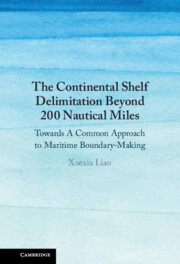 The Continental Shelf Delimitation Beyond 200 Nautical Miles
The Continental Shelf Delimitation Beyond 200 Nautical Miles Book contents
- The Continental Shelf Delimitation Beyond 200 Nautical Miles
- The Continental Shelf Delimitation Beyond 200 Nautical Miles
- Copyright page
- Contents
- Figures
- Table of Cases
- Table of Treaties
- Foreword
- Preface
- Abbreviations
- 1 Legal Uncertainties in the Continental Shelf Delimitation beyond 200 NM
- Part I Overlapping Entitlements to the Continental Shelf beyond 200 Nautical Miles
- Part II Delimitation Methodology for the Continental Shelf beyond 200 Nautical Miles
- 5 Conceptual Framework of Delimitation Methodology
- 6 Determination of the Area of Overlapping Entitlements
- 7 Geomorphological and Geological Circumstances
- 8 Geographical Circumstances
- 9 Towards a Common Approach to Maritime Delimitation within and beyond 200 NM
- Book part
- Bibliography
- Index
7 - Geomorphological and Geological Circumstances
from Part II - Delimitation Methodology for the Continental Shelf beyond 200 Nautical Miles
Published online by Cambridge University Press: 08 October 2021
- The Continental Shelf Delimitation Beyond 200 Nautical Miles
- The Continental Shelf Delimitation Beyond 200 Nautical Miles
- Copyright page
- Contents
- Figures
- Table of Cases
- Table of Treaties
- Foreword
- Preface
- Abbreviations
- 1 Legal Uncertainties in the Continental Shelf Delimitation beyond 200 NM
- Part I Overlapping Entitlements to the Continental Shelf beyond 200 Nautical Miles
- Part II Delimitation Methodology for the Continental Shelf beyond 200 Nautical Miles
- 5 Conceptual Framework of Delimitation Methodology
- 6 Determination of the Area of Overlapping Entitlements
- 7 Geomorphological and Geological Circumstances
- 8 Geographical Circumstances
- 9 Towards a Common Approach to Maritime Delimitation within and beyond 200 NM
- Book part
- Bibliography
- Index
Summary
Maritime delimitation excludes relevance of geomorphology or geology from the delimitation process in the continental shelf and the EEZ delimitation within 200 nautical miles. Whether geomorphological or geological factors will re-emerge in the delimitation of the continental shelf beyond 200 nm is thus a topic of continuing interest and perplexity. This chapter examines this issue from three perspectives: first, the relationship between the basis of entitlement and the delimitation method; second, "the most natural prolongation" argument in the delimitation of the continental shelf beyond 200 nm; and third, geomorphological and geological factors as a relevant circumstance. After reviewing the relevant hypotheses, jurisprudence, and State practice, it concludes that geomorphological and geological factors are unlikely to be taken into account by the judiciary to in the drawing of the maritime boundary in the delimitation of the continental shelf beyond 200 nm.
Keywords
- Type
- Chapter
- Information
- The Continental Shelf Delimitation Beyond 200 Nautical MilesTowards A Common Approach to Maritime Boundary-Making, pp. 227 - 267Publisher: Cambridge University PressPrint publication year: 2021


